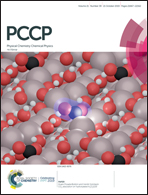Double-platelet Pd@ZnO microcrystals for NO2 chemical sensors: their facile synthesis and DFT investigation†
Abstract
Double-platelet, single-platelet and spherical ZnO microcrystals were fabricated via a facile and controllable hydrothermal method. The morphology of the ZnO microcrystals and the exposure ratio of the (001) crystal surface were regulated by adjusting the pH of the solution. The ZnO microcrystals were modified with Pd nanoparticle loading by simple calcining, and the interaction of Pd nanoparticles (NPs) on the ZnO crystal surface increased its oxygen vacancy content. A micro-amount (0.05 wt%) of Pd NP-doped ZnO double-platelets (D-ZnO-0.05) enhanced the gas sensing of the sensor to 3.5 times that of pure double-platelet ZnO. The gas sensing results indicate that D-ZnO-0.05 exhibits a high response (71.2 for NO2 with 25 ppm), fast response/recovery (25 s/21 s), and superior long-term stability (remained at around 95.5% after 35 days). The enhancement in the gas sensing could be attributed to the catalysis of Pd NPs and the increase in the number of oxygen vacancies as a result of Pd loading. The band structure of D-ZnO-0.05 could be effectively tuned by introducing Pd nanoparticles, as shown in density functional theory (DFT) calculations. The Pd dopant and oxygen vacancies reduce the band gap of the ZnO(001) crystal materials, resulting in excellent sensor performance. It is believed that the D-ZnO-0.05 microcrystals could provide inspiration for crystal growth studies and high NO2 gas sensing.



 Please wait while we load your content...
Please wait while we load your content...